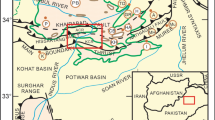Abstract
Sandstone-hosted roll-type uranium deposits were found to occur in the Middle Jurassic Zhiluo Formation sandstone in Dongsheng area, north of the Ordos basin. The uranium occurs mainly as coffinite. Some of the coffinite is intergrown intimately with secondary pyrite, indicating simultaneous precipitation. The pyrite has δ34S values from −34‰ to +18‰, suggesting an origin of bacterial sulfate reduction. Calcite cement of the host sandstones has δ13C values from +0.3‰ to −27.6‰. The most negative δ13C value is more negative than those of terrestrial higher plants-derived organic matter in the Jurassic in the basin, thus the carbon of the calcite cement is likely derived from oil and natural gas, most likely from mixing of preexisting inorganically derived CO2 and methane-derived CO2. The hypothesis is supported by the great, number of oil/gas inclusions found in the calcite cement and healed fractures through quartz grains. Interestingly, in the sandstone with high content of uranium, secondary pyrite has δ34S as light as −34‰, calcite cement has δ13C lower than −10‰. Thus, it can be concluded that sulfate reducing bacteria likely oxidized hydrocarbons, and directly or indirectly reduced uranium (VI) to uranium (IV).
Access this chapter
Tax calculation will be finalised at checkout
Purchases are for personal use only
Preview
Unable to display preview. Download preview PDF.
Similar content being viewed by others
References
Aharon P, Fu B (2000) Microbial sulfate reduction rates and sulfur and oxygen isotope fractionations at oil and gas seeps in deepwater Gulf of Mexico. Geochim Comochim Acta 64:233–246
Boetius A, Ravenschlag K, Schubert CJ, Ricker D, Widdel F, Gleseke A, Amann R, Jorgensen BB, Witte U, Pflannkuche O (2000) A marine microbial consortium apparently mediating anaerobic oxidation of methane. Nature 407:623–626
Cai CF, Hu WS, Worden RH (2001) Thermochemical sulfate reduction in Cambro-Ordovician carbonates in Central Tarim. Marine and Petroleum Geology 18:729–741
Cai CF, Mei BW, Ma T, Chen CP, Li W, Liu CQ (1997) Approach to Fluid-Rock Interaction in Tarim Basin. Bei**g, Geological Publishing House (in Chinese)
Cai CF, Worden RH, Wang QH, **ang TS, Zhu JQ, Chu XL (2002) Chemical and isotopic evidence for secondary alteration of natural gases in the Hetianhe Field, Bachu Uplift of the Tarim Basin. Organic Geochemistry 43:1415–1427
Chen JP, Huang DF (1997) The source of oils in Jurassic coal mine in the southeast of Ordos basin. Acta Sedimentological Sinica 15(2): 100–104 (in Chinese)
Curiale JA, Bloch S, Rafalska-Bloch J, Harrison WE (1983) Petroleum-related origin for uraniferous organic-rich nodules of southwestern Oklahoma. AAPG Bull 67:588–608
George SC, Ahmed M, Liu K, Volk H (2004) The analysis of oil trapped during secondary migration. Orgc Geochem 35:1489–1511
Jensen ML (1958) Sulfur isotopes and the origin of sanstone-type uranium ore deposits. Economic Geology 53:598–616
Kaplan IR, Rittenberg SC (1964) Microbical fractional of sulfur isotopes. J Gen Micro 34:195–212
Lovley DR, Philips EJP, Gorby YA, Landa ER (1991) Microbial reduction of uranium. Nature 350:413–416
Nakashimima S, Disnar JR, Perruchot A, Trichet J (1984) Experimental study of mechanisms of fixation and reduction of uranium by sedimentary organic matter under diagenetic or hydrothermal conditions. Geochim Comochim Acta 48:2321–2329
Rackley RI (1972) Environment of Wyoming Tertiary uranium deposits. AAPG Bull 56:755–774
Reynolds RL, Golhaber MB (1982) Biogenic and nonbiogenic oreforming processes in the South Texas Uranium District: Evidence from the Panna Maria deposit. Economic Geology 77: 541–556
Sani RK, Peyton BM, Amonette JE, Geesey GG (2004) Reduction of uranium (VI) under sulfate-reducing conditions in the presence of Fe(III)-(hydr) oxides. Geochim Cosmochim Acta 68:2639–2648
Spear JR, Figueroa LA, Honeyman BD (2002) Modeling the removal of uranium (VI) from aqueous solutions in the presence of sulfate reducing bacteria. Applied Microbiology and Biotechnology 60:192–199
Spirakis CS (1996) The roles of organic matter in the formation of uranium deposits in sedimentary rocks. Ore Geology 11:53–69
Ulrich GW, Stefano MB, Michael EB (2001) Hypersulfidic deep biosphere indicates extreme sulfur isotope fraction during single-step microbial sulfate reduction. Geology 29:647–650
**a YL, Lin JR, Liu HB, Fan G, Hou Y (2003) Research on geochronology and sandstone-hosted uranium ore formation in major uranium productive basins, northern China. Uranium Geology 19(3): 129–136 (in Chinese)
Zhang CL, Li YL, Wall JD, Larsen L, Sassen R, Huang YS, Wang Y, Peacock A, White DC, Horita J, Cole DR (2002) Lipid and carbon isotopic evidence of methane-oxidizing and sulfate-reducing bacteria in association with gas hydrates from the Gulf of Mexico. Geology 30:239–242
Author information
Authors and Affiliations
Editor information
Editors and Affiliations
Rights and permissions
Copyright information
© 2005 Springer-Verlag Berlin Heidelberg
About this paper
Cite this paper
Cai, C., Li, H., Luo, X. (2005). Petroleum-related origin for sandstone-hosted uranium deposits in the Dongsheng area, Ordos Basin (China). In: Mao, J., Bierlein, F.P. (eds) Mineral Deposit Research: Meeting the Global Challenge. Springer, Berlin, Heidelberg. https://doi.org/10.1007/3-540-27946-6_59
Download citation
DOI: https://doi.org/10.1007/3-540-27946-6_59
Publisher Name: Springer, Berlin, Heidelberg
Print ISBN: 978-3-540-27945-7
Online ISBN: 978-3-540-27946-4
eBook Packages: Earth and Environmental ScienceEarth and Environmental Science (R0)




